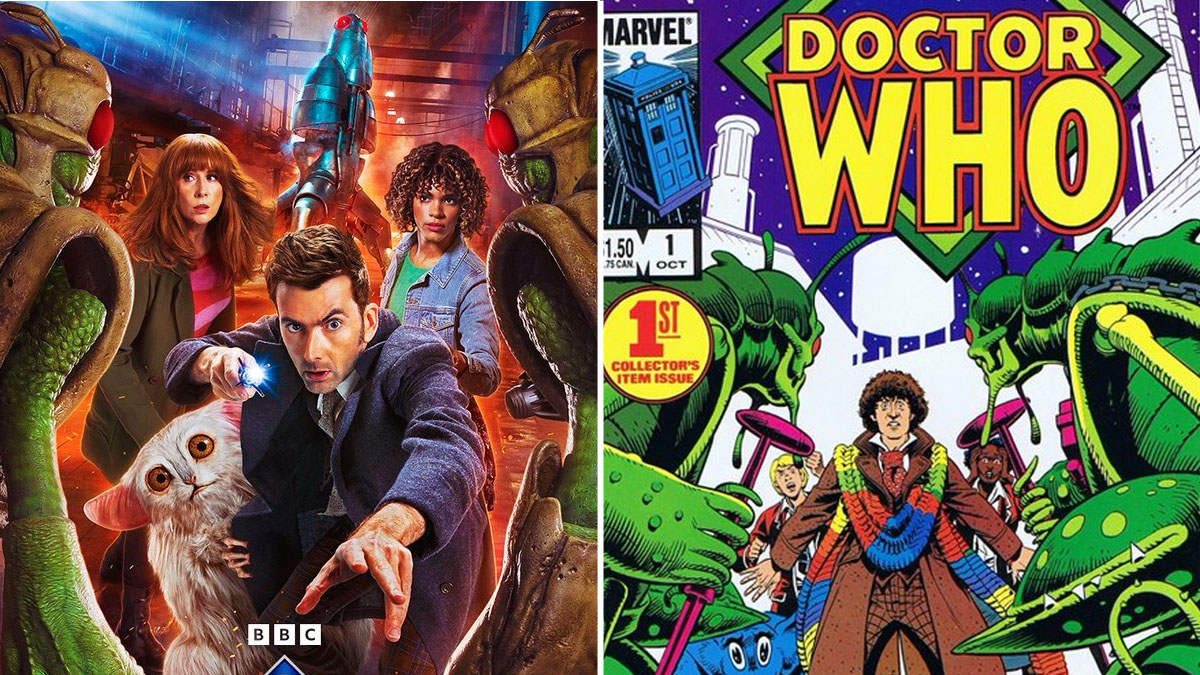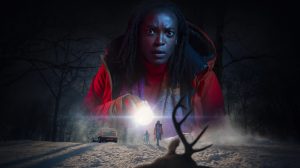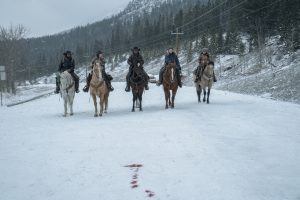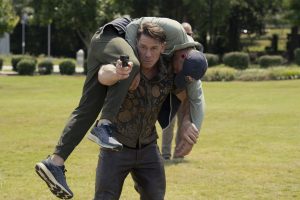
Warning: contains spoilers for Doctor Who: The Star Beast.
The first of the new David Tennant and Catherine Tate-fronted episodes is called simply “The Star Beast”, a title it shares with the 1980 Doctor Who Weekly comic strip (published in the US by Marvel Comics as “Stan Lee Presents: Doctor Who”) “Doctor Who and the Star Beast”, featuring the Fourth Doctor as played by Tom Baker.
The TV special stars Miriam Margolyes as the voice of the fluffy alien “Beep the Meep”, who first appeared in that comic. And if we put the poster for the special alongside the cover of that comic (see above) there are… similarities.
It wouldn’t be the first time the Doctor Who TV series has adapted stories from other mediums. The most famous example would be when Paul Cornell was invited to adapt the Seventh Doctor novel he had written for Virgin New Adventures, “Human Nature”, which saw the Doctor abandon his Time Lord identity to become the ordinary human teacher, John Smith.
The now-classic story for the first new series of Doctor Who, “Dalek”, was loosely based on writer Robert Shearman’s Big Finish audio, “Jubilee”. “Rise of the Cybermen” and “Age of Steel” credits the Marc Platt play “Spare Parts” (a much better and creepier Cyberman origin story). Even the legendary “Blink” was based on Steven Moffat’s short story for the Doctor Who Annual, “What I Did on My Christmas Holidays by Sally Sparrow”.
For the most part, however, comics have been left out, bar a blink-and-you’ll-miss-it glimpse of Abslom Daak: Dalek Killer among a list of mugshots in the episode “Time Heist”, and UNIT officer Muriel Frost, who appeared in several comics and audios before being unceremoniously bumped off at the cliffhanger to “Aliens of London”.
But we’re not just talking about sly references to or even an indirect sequel to the events of the comic strip. The opening credits of the story credit the comics lead writer Pat Mills, and artist Dave Gibbons, right alongside Russell T Davies himself.
Doctor Who’s First Proper Comics-to-TV Adaptation
The Star Beast comic strip was written by John Wagner and Patt Mills, known to British comics fans for their work on the likes of 2000AD, Dan Dare and Roy of the Rovers. Wagner also co-wrote the graphic novel on which David Cronenberg’s A History of Violence is based.
The art of the comic, meanwhile, comes from none other than the legendary Dave Gibbons, the artist who drew Alan Moore’s Watchmen. In short, it’s harder to imagine a team that better encapsulated the grittiness of 1980s British comics.
Gibbons’ designs for the Meep spaceship and the Wrarth Warriors were faithfully recreated in the TV adventure, and during the May 2022 filming, both Gibbons and Pat Mills visited the set of the London steelworks (actually Uskmouth Power Station in Newport, Wales) where the Meep’s ship crashed. Tennant confessed on the in-episode commentary for “The Star Beast” that he was shameless in getting both to sign memorabilia.
Doctor Who producer Phil Collinson and Tennant both remembered owning the original comic strip – which they recall came with a set of free transfers – as children, and Collinson still has a copy stored away in the loft. A wise move from him, as it’s a challenge to find now. Unless you know someone who has been stockpiling the comics, second-hand copies of the trade paperback collection that includes “The Star Beast” are currently only available for in the region of £70 second-hand. However, it has also been adapted by Big Finish, starring Tom Baker himself.
But if you do find the comic, you’ll note how much it is basically a blueprint for modern Who, circa 2005. “Doctor Who and the Star Beast” will seem very familiar if you have seen any of Russell T Davies’ episodes set in the present day. At one point Tom Baker’s Fourth Doctor wears a sombrero, something Steven Moffat must be furious he never got to put on Matt Smith.
What Happens in the Comic
First of all: the setting. “Doctor Who and the Star Beast” takes place in a British Northern town in the 1980s, where there are rumours that a UFO has crashed. The rumours are dismissed because aliens would never go to a dump like the fictional town of Blackcastle.
The comic story has two strands. One is the story of two kids finding an adorable alien called Beep the Meep and taking him (the Meep’s pronouns are “he/him” in the comic) home. You might call it an E.T. parody, except E.T. wasn’t released until two years after the comic was published (although director Rachel Talalay returned the favour by paying homage to E.T.’s ‘alien hiding in a pile of cuddly toys’ scene).
Meanwhile, the Doctor accidentally lands on a ship of much scarier-looking aliens called the Wrarth, who promptly knock him out and secretly plant a bomb inside him, believing he will lead them to this Meep. It’s tremendous fun, and honestly, we hope Davies inserts a bomb in the Doctor at the next best opportunity.
Shenanigans ensue, until eventually we discover the story’s big twist – that Beep the Meep is not a sweet and innocent cute ball of fluff. Beep the Meep is actually a dastardly and evil cute ball of fluff.
As in the TV special, the Meeps, once peaceful and advanced, were mutated. In the comic, the mutation is caused by a Black Sun, and we’ve got to give Russell T Davies all due credit for “Psychedelic Sun”, a name that is even more eighties-comic-book than the eighties comic book name.
The mutation creates a race of twee yet unstoppable conquerors, and here the TV adaptation misses out on some truly grade-A material from the comic. What is the point of this deal with Disney if Doctor Who can’t have its evil aliens singing “Hey ho! Hey ho! It’s off the war we go!”? Or “Hoppity hop! Boppity bop! Who’s next for the chop?” as they line prisoners up for the guillotine?
Then there’s a big climax, the entire planet is endangered, and the Doctor does something clever. It all moves along in a very Doctor Who way. A very post-Russell T Davies’-era Doctor Who way, to be frank.
The First Modern Who Story?
Davies and Moffat have clearly both read this comic before. If you have watched Martha Jones’s debut in “Smith & Jones”, or the Eleventh Doctor’s first adventure “The Eleventh Hour”, you will recognise the plot beats here.
So, if you were wondering why Russell T Davies has decided to use his grand return to adapt an old 1980s comic strip, the answer could be ‘because that’s what he has been doing all along’. The gritty everyday-ness of the setting, the pop culture references, the humour.
As David Tennant explains in the In-Episode Commentary for “The Star Beast”, available to watch on BBC iPlayer: “It’s got that mix of the domestic and the fantastical that has always worked for Doctor Who and that specifically Russell has, it’s a seam that Russell has mined, bringing the family into the story.”
All that’s been intrinsic to Doctor Who from the beginning, but the specific flavour of these elements in this comic feels like Davies or Moffat writing the kind of series-opener they expect to be a jumping-on point.
But– why? If this story is the foundation of so much of the Doctor Who we have been watching for the last 18 years, why would Russell T Davies take us back to the source now?
Even when not writing anniversary specials, Davies has never been above playing us the greatest hits, but this time there’s a bit more to it than that. And to understand why, we have to look at the stuff Davies added to the original comic story – the important stuff.
What RTD Added to the Comic Story
If we take away everything from the TV special that was in the comic, we’re left with two key strands: the first is the big meta-arc stuff, the character beats that Russell T Davies needed to hit in order to get Tennant’s Doctor and Donna Noble back in play.
The second is that Russell T Davies asked for, and was given, one of the biggest shows on the BBC, then partnered with Disney, accruing a budget and audience of millions, which combined to make probably the biggest international platform a TV writer could hope to have in 2023.
Then he used it to say, “Trans rights”.
Was it subtle? Christ no. But we are living in times when it is more important to be understood than it is to look clever.
Russell T Davies resurrected his favourite childhood show, turned it into a media behemoth, then went off and wrote a TV series about AIDS and the rise of fascism in the UK then came back and did it again. He is not worried that you think he has a political axe to grind.
So, to deliver all those ingredients, why not hang it off the most archetypal Nu-Who plot you can find? Because writing for a TV series’ 60th year comes with its perks. Not just the limitless potential, but that absolutely enormous toybox.
When Davies was writing “Gridlock”, the episode where everyone is trapped in a flying underground traffic jam, he needed a big monster to lurk beneath all the cars and eat anyone who flies too low. So he figured, why not giant crabs? And of course, Doctor Who had a species of giant crab monsters on hand. Because Doctor Who always has something on hand.
By picking up an entire plot from the comics, Russell T Davies is doing what he’s always done: telling big, fun stories that matter, and playing with every toy in Doctor Who’s toybox to do it.
Doctor Who continues with “Wild Blue Yonder” on Saturday December 2 on BBC One and iPlayer in the UK and Disney+ around the world.
The post Doctor Who: How Russell T Davies Adapted the Original Star Beast Comic appeared first on Den of Geek.





